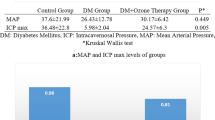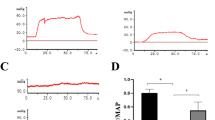Abstract
We hypothesized that the administration of the superoxide dismutase (SOD) mimetic Tempol (4-hydroxy-2, 2, 6, 6-tetramethylpiperidine 1-oxyl) may reverse diabetes-induced erectile dysfunction. To test this hypothesis, reactive oxygen species-related genes (SOD1, SOD2, GP × 1, CAT, NOS2, NOS3) were tested, erectile functional studies and immunohistochemical analysis were carried out in diabetic rats treated with or without Tempol. Thirty Sprague–Dawley (3–4months old) rats were divided into three groups (n=10 each), 20 with diabetes (diabetic control and Tempol treatment) and 10 healthy controls. At 12 weeks after the induction of diabetes by streptozotocin and Tempol treatment, all groups underwent in vivo cavernous nerve stimulation. Rat crura were harvested and the expression of antioxidative defense enzymes were examined by semi-quantitative reverse transcriptase PCR (RT–PCR). To confirm the RT–PCR results, we carried out immunohistochemistry (IHC) for catalase (CAT) and iNOS (NOS2). Nitration of tyrosine groups in proteins was also examined by IHC. Mean intracavernous pressure in the diabetic group was significantly lower than in the healthy controls (P <0.001) and was reversed by Tempol treatment (P <0.0108). NOS2 protein expression was significantly increased in diabetic animals compared with healthy controls and Tempol restored NOS2 protein level. Nitrotyrosine was also higher in diabetic animals and although Tempol treatment decreased its formation, it remained higher than that found in healthy controls. This study suggests that Tempol treatment increased erectile function through modulating oxidative stress-related genes in diabetic rats. This is the first report about the relationship between diabetes-induced erectile dysfunction and oxidative stress, and antioxidative therapy using the superoxide dismutase mimetic, Tempol, to restore erectile function.
This is a preview of subscription content, access via your institution
Access options
Subscribe to this journal
Receive 8 print issues and online access
$259.00 per year
only $32.38 per issue
Buy this article
- Purchase on Springer Link
- Instant access to full article PDF
Prices may be subject to local taxes which are calculated during checkout





Similar content being viewed by others
References
American Diabetes Association., http://www.diabetes.org/about-diabetes.jsp. accessed 3 September 2008.
Hakim LS, Goldstein I . Diabetic sexual dysfunction. Endocrinol Metab Clin North Am 1996; 25: 379–400.
Billups KL . Erectile dysfunction as an early sign of cardiovascular disease. Int J Impot Res 2005; 17: 19–24.
Schwarz ER, Rastoji S, Rodriguez JJ, Kapur V, Sulemanjee N, Gupta R . A multidisciplinary approach to assess erectile dysfunction in high-risk cardiovascular patients. Int J Impot Res 2005; 17: 37–43.
Rendell MS . Sildenafil for treatment of erectile dysfunction in men with diabetes: a randomized controlled trial. Sildenafil Diabetes Study Group. JAMA 1999; 281: 421–426.
Johanson JS, Harris AK, Rychly DJ, Ergul A . Oxidative stress and the use of antioxidants in diabetes: linking basic science to clinical practice. Cardiovasc Diabetol 2005; 4: 5.
Ceriello A . New insights on oxidative stress and diabetic complications may lead to a ‘causal’ antioxidant therapy. Diabetes Care 2003; 26: 1589–1596.
Musicki B, Burnett AL . Endothelial dysfunction in diabetic erectile dysfunction. Int J Impot Res 2007; 19: 129–138.
Marchioli R, Schweiger C, Levantesi G, Tavazzi L, Valagussa F . Antioxidant vitamins and prevention of cardiovascular disease: epidemiological and clinical trial data. Lipids 2001; 36: S53–S63.
Cuzzocrea S, Riley DP, Caputi AP, Salvemini D . Antioxidant therapy: a new pharmacological approach in shock, inflammation, and ischemia/reperfusion injury. Pharmacol Rev 2001; 53: 135–159.
Muscoli C, Cuzzocrea S, Riley DP, Zweier JL, Thiemermann C, Wang ZQ et al. On the selectivity of superoxide dismutase mimetics and its importance in pharmacological studies. Br J Pharmacol 2003; 140: 445–460.
Simonsen U, Rodriguez-Rodriguez R, Dalsgaard T, Buus NH, Stankevicius E . Novel approaches to improving endothelium-dependent nitric oxide-mediated vasodilation. Pharmacol Rep 2009; 61: 105–115.
Thiemermann C . Membrane permeable radical scavengers (tempol) for shock, ischemia reperfusion injury, and inflammation. Crit Care Med 2003; 31: 76–84.
Quinlan DM, Nelson RJ, Partin AW, Mostwin JL, Walsh PC . The rat as a model for the study of penile erection. J Urol 1989; 141: 656–661.
Yamanaka M, Shirai M, Shiina H, Tanaka Y, Enokida H, Tsujimura A et al. Vascular endothelial growth factor restores erectile function through nhibition of apoptosis in diabetic rat penile crura. J Urol 2005; 173: 318–323.
Sullivan CJ, Teal TH, Luttrell IP, Tran KB, Peters MA, Wessells H . Microarray analysis reveals novel gene expression changes associated with erectile dysfunction in diabetic rats. Physiol Genomics 2005; 23: 192–205.
Moncada S, Palmar RM, Higgs EA . Nitric Oxide: physiology, pathophysiology, and pharmacology. Pharmacol Rev 1991; 43: 109–142.
Bivalacqua TJ, Usta MF, Champion HC, Adams D, Namara DB, Abdel-Mageed AB et al. Gene transfer of endothelial nitric oxide synthase partially restores nitric oxide synthesis and erectile function in streptozotocin diabetic rats. J Urol 2003; 169: 1911–1917.
Giardino I, Edelstein D, Brownlee M . BCL-2 expression or antioxidants prevent hyperglycemia-induced formation of intracellular advanced glycation endproducts in bovine endothelial cells. J Clin Invest 1996; 97: 1422–1428.
Brownlee M . Biochemistry and molecular cell biology of diabetic complications. Nature 2001; 414: 813–820.
Spitaler MM, Graier WF . Vascular targets of redox signaling in diabetes mellitus. Diabetologia 2002; 45: 476–494.
Soriano FG, Virag L, Jagtap P, Szabo E, Mabley JG, Liaudet L . Diabetic endothelial dysfunction: the role of poly (ADP-ribose) polymerase activation. Nat Med 2001; 7: 108–113.
Usta MF, Bivalacqua TJ, Yang DY, Ramanitharan A, Sell DR, Viswanathan A et al. The protective effect of aminoguanidine on erectile function in streptozotocin diabetic rats. J Urol 2003; 170: 1437–1442.
Ren XY, Li YN, Qi JS, Niu T . Peroxynitrite-induced protein nitration contributes to liver mitochondrial damage in diabetic rats. J Diabetes Complications 2008; 22: 357–364.
Cheng X, Xia Z, Leo JM, Pang CC . The effect of N-acetylcysteine on cardiac contractility to dobutamine in rats with streptozotocin-induced diabetes. Eur J Pharmacol 2005; 519: 118–126.
Rao VS, Santos FA, Silva RM, Teixiera MG . Effects of nitric oxide synthase inhibitors and melatonin on the hyperglycemic response to streptozotocin in rats. Vascul Pharmacol 2002; 38: 127–130.
Taniyama Y, Griendling KK . Reactive oxygen species in the vasculature: molecular and cellular mechanisms. Hypertension 2003; 42: 1075–1081.
Ceriello A, Quagliaro L, D’Amico M, Di Filippo C, Marfella R, Nappo F et al. Acute hyperglycemia induces nitrotyrosine formation and apoptosis in perfused heart from rat. Diabetes 2002; 51: 1076–1082.
Grishko V, Rachek L, Musiyenko S, Ledoux SP, Wilson GL . Involvement of mtDNA damage in free fatty acid-induced apoptosis. Free Radic Biol Med 2005; 38: 755–762.
Yamanaka M, Shirai M, Shiina H, Tanaka Y, Tsujimura A, Matsumiya K et al. Diabetes induced erectile dysfunction and apoptosis in penile crura are recovered by insulin treatment in rats. J Urol 2003; 170: 291–297.
Acknowledgements
We thank Dr Roger Erickson for his support and assistance with the preparation of the paper. This study was supported by Grants RO1DK075524, T32DK007790 from the NIH.
Author information
Authors and Affiliations
Corresponding author
Rights and permissions
About this article
Cite this article
Kawakami, T., Urakami, S., Hirata, H. et al. Superoxide dismutase analog (Tempol: 4-hydroxy-2, 2, 6, 6-tetramethylpiperidine 1-oxyl) treatment restores erectile function in diabetes-induced impotence. Int J Impot Res 21, 348–355 (2009). https://doi.org/10.1038/ijir.2009.28
Received:
Revised:
Accepted:
Published:
Issue Date:
DOI: https://doi.org/10.1038/ijir.2009.28
Keywords
This article is cited by
-
The effects of long-term administration of tadalafil on STZ-induced diabetic rats with erectile dysfunction via a local antioxidative mechanism
Asian Journal of Andrology (2012)
-
Experimental priapism is associated with increased oxidative stress and activation of protein degradation pathways in corporal tissue
International Journal of Impotence Research (2010)



